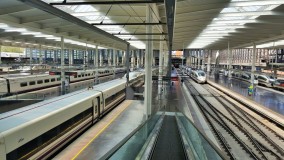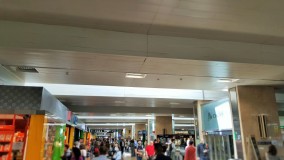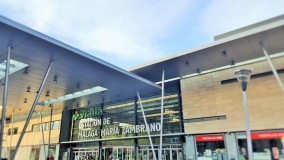Related Content
Content
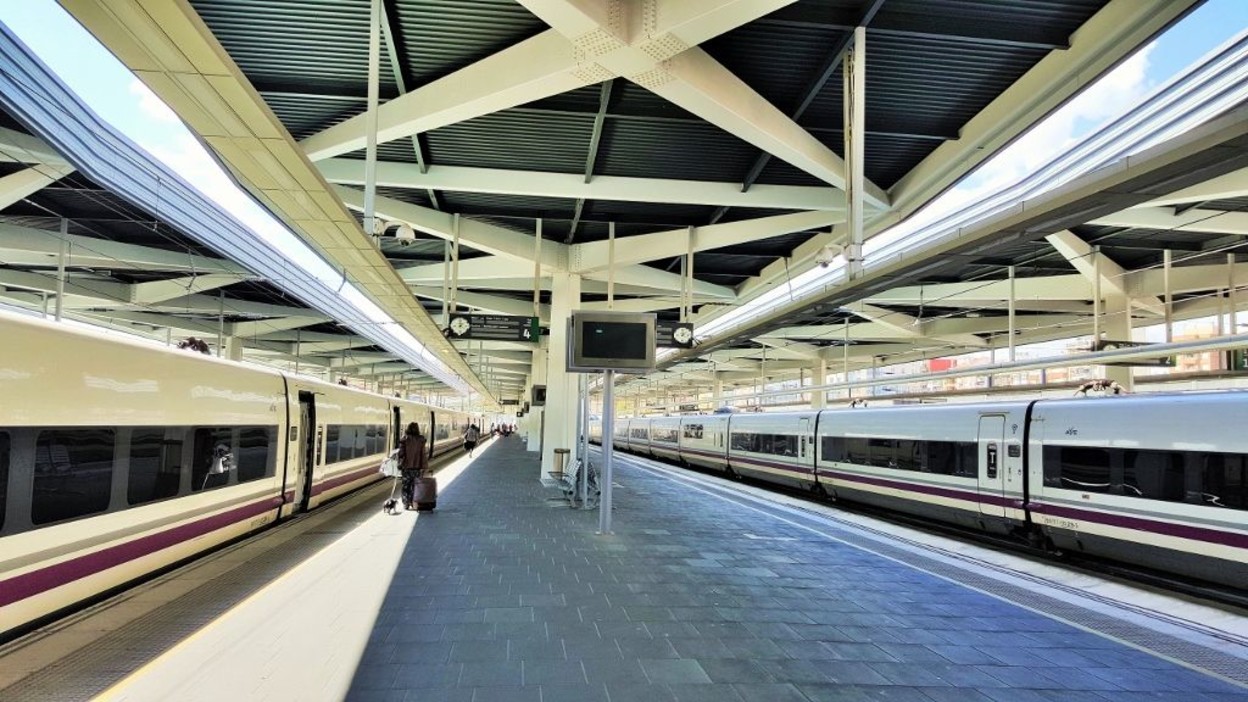
Spain
This guide to travelling by train in Spain will tell you all you need to know about the major stations, how the ticketing works and how to travel on the fabulous trains.
Share
Helpful links:
There’s a lot to love about travelling by train in Spain
The country has more high speed lines than any other in Europe, the trains that do and don't use them are rather fabulous and comparatively comfortable - and the scenery can be incredible.
But if you’re not Spanish, travelling in Spain by train can seem a tad bewildering, hence the weight of info below!
Temporary Covid-19 changes:
The Covid-19 travel advice page on the Spanish national rail operator, Renfe, website is available here.
The key piece of info is that wearing of face masks on trains is mandatory,
International train service alterations:
The international trains from and to Spain have been particularly impacted by the pandemic.
The overnight Trenhotel services from both Hendaye/Hendaia and Madrid to Lisbon have been permanently withdrawn.
On the high speed route between Figueres and Perpignan only 1 x train is available in each direction on the Barcelona <> Paris route and the daily Barcelona <> Lyon service is still operating.
However the Madrid <> Marseille service remains suspended.
What's particularly worth knowing:
The SEVEN key things most worth knowing about taking the trains in Spain are:
(1) Renfe is the national company which operates most train services including all express trains, hence most trains carry the Renfe branding
However, Adif is the name of the company that is responsible for the stations that the Renfe trains use.
So the presence of a station is often indicated by a sign saying 'Adif' - white letters on a black background.
(2) Renfe doesn't have a monopoly on Spanish train services and one of the exceptions is the Euskotren network of lines in north-east Spain, around Bilbao and San Sebastian/Donastia.
(3) Renfe's daytime train services are placed into three broad categories;
- larga-distancia
- media-distancia
- local/commuter train service; these are named differently depending on the city, ‘Cercanias’ is a more common name, but ‘Rodalies’ is used in Barcelona.
*Spain is a large country, so some media-distancia routes can be more than three hours long.
(4) Advance discounted ticket prices are available on routes taken by the larga-distancia services, but not on most routes taken by the media-distancia services.
(5) Seat reservations are compulsory on all larga-distancia services and on most media-distancia services, including all journeys on which the trains are specifically branded MD ‘Media-Distancia’
Reservations are automatically included when booking tickets online or at stations.
(6) Unless you are taking a local/commuter train, avoid turning up at a station in the expectation of buying a ticket and hopping on the next train to depart.
On the majority of Spanish train routes, gaps of more than three hours between departures are the norm.
(7) When taking AVE (high-speed) train services, you will usually encounter a procedure similar to checking-in for a flight.
Tickets will be checked before accessing a luggage screening area and then tickets will usually be checked again at the entrance to the via (platform/track) that your train will be departing from.
It inevitably takes time to process all the passengers, so aim to be at the station a minimum of 15 mins prior to departure if you will be taking any of these train services – AVE, Alvia, Altaria, Avant or Euromed


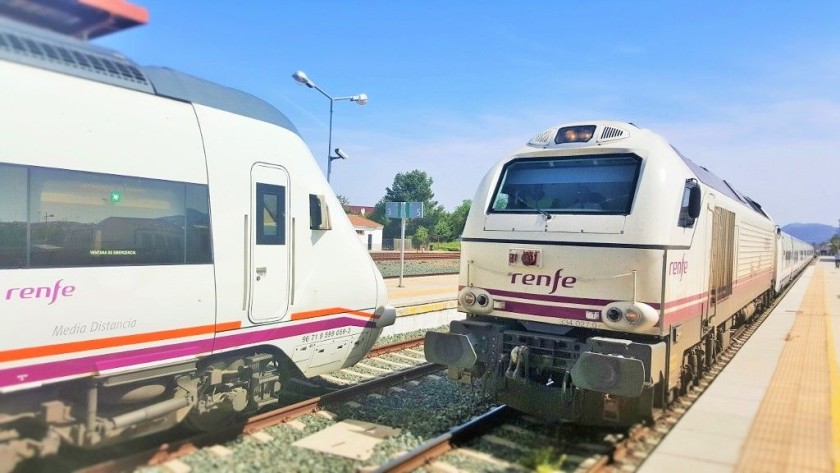


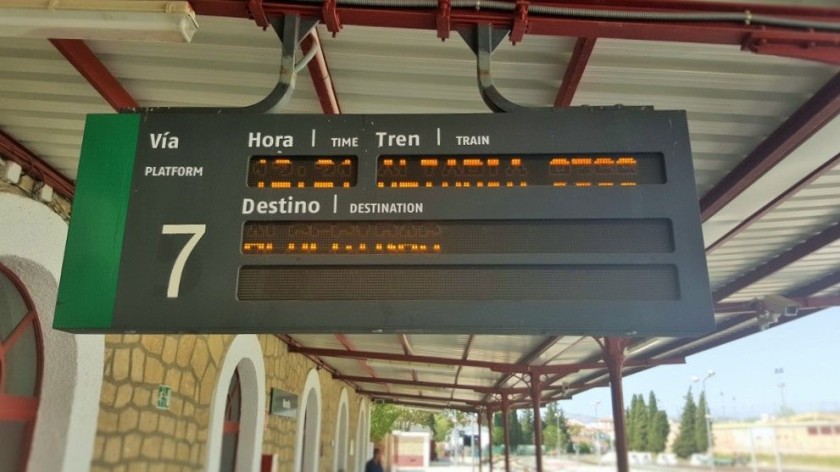


Travelling on the Spanish trains:
The trains in Spain are far from plain; sorry we couldn’t resist that one, but the trains used on the larga-distancia routes undoubtedly have the wow factor!
However, taking a Spanish express train can seem initially bewildering, particularly if you want to travel on multiple different routes.
The multiple different train services:
What soon becomes clear when looking up Spanish rail journeys is the multiple different types of train service operated by RENFE.
Don’t be overly concerned about this for these three reasons:
- More often than not you won’t have a choice of more than one train service, particularly when travelling long distance.
- On routes on which multiple types of train service do operate, certain types of train service TEND to be cheaper than others when booking ahead, so become the logical choice when making a booking.
- The distinction between the train services is often technical (see below) so isn’t indicative of differences in the on-board experience.
The trains which travel on high speed lines: the AVE, Alvia, IC (Altaria) and Avant services are also classified as 'Alta Velocidad' services.
When these train services all depart from a particular part of a station, you may encounter a sign pointing the way to the 'Alta Velocidad' trains.
Technical Explanation Alert:
There is a piece of railway knowledge that can make the differences between the types of train service in Spain easier to understand.
It’s to do with the space between the rails on the track, which is known as the ‘gauge’, in Spain this is wider than on the railway tracks in other western European countries that use a standard gauge.
However, the Spanish high speed lines have been constructed to this standard gauge used elsewhere in Europe, so when Spanish express train services travel on to destinations not served by the high speed lines, they have to switch between the gauges.
This matters because the names of some Spanish train services are indicative of the fact that they switch gauges.
You may not care about that, we of course find it fascinating, but the key point is that you don’t need to care about it.
Though it does indicate when a journey will not be entirely be at high speed; the trains change gauges when they leave the high speed lines.
The Larga-Distancia (long-distance) trains:
Reservations are compulsory and included with the ticket purchase on the Larga-Distancia services; which can be placed into four sub categories:
(1) Trains that spend the entirety of their journeys travelling on the high speed lines = the AVE trains.
(2) Trains which spend some of the journeys on the high speed lines and then travel on to destinations not served by the high speed lines = the Alvia and the Torre Oro train.
These are the gauge-changing trains (see above).
Note that you don't have to travel on an AVE train service in order to travel on a high speed line.
Alvia trains provide most of the services between Madrid and northern Spain.
(3) IC trains . which don’t travel on high speed lines at all = the IC (Talgo) trains.
Intercity (IC) trains are 2nd class only.
(4) Trenhotel overnight trains.
All Trenhotel services have been suspended until further notice due to the Covid-19 crisis.
The Media-Distancia trains:
These train services fall into three categories:
(1) Avant (Av): These are 2nd class (Turista class) only trains which spend the entirety of their journeys travelling on high speed lines.
Reservations are compulsory and included with the ticket purchase.
(2) Media Distancia (MD): These are the train services, which are specifically branded ‘Media Distancia’ on timetables.
But it is a broad term, which covers four types of train services:
- Trains which travel fairly lengthy routes between cities that are not taken by direct express (larga-distancia) trains.
- Trains which still travel on the routes which have been abandoned by express trains, because those express trains have been switched to the high speed lines.
When that is the case, these MD services can provide a slower, but cheaper, alternative to taking a high speed train. - Trains which share the non-high speed sections of routes taken by Alvia and IC services.
On these routes these MD train services tend to be cheaper, than those alternative 'larga-distancia' services. - Routes which are also taken by Regional Express trains; and on these routes the MD trains provide a faster service because they skip more stations.
Reservations are compulsory (except on the Barcelona <> Port Bou via Girona route) on these branded MD services and included with the ticket purchase.
(3) Regional Express services on which reservations aren’t available (see below).
The Regional-Express trains:
On the Regional Express services reservations aren’t available, so they're the only trains which travel between towns and cities in Spain on which seat reservations are not mandatory.
Though these trains sometimes don't live up to their name for two reasons;
- they stop at most stations once they travel outside cities
- they can travel comparatively long distances.
However, in cities they tend to skip most stations served by the local/commuter trains.
Boarding:
If you are taking a train which has compulsory reservation, the Coche (coach/carriage) and Plaza (seat numbers) are on your ticket.
On the larga and media-distancia services, virtually all of the coaches/carriages only have one door on each side of the train, so you don’t have to choose between doors when boarding.
Then when you’re on the train, look for the seat number, there is nothing else to indicate which seats are reserved and which are free.
For any journey by a larga-distancia train service, the AVE, Alvia, IC and Torre Oro trains you must travel in the seats you have been assigned.
This is because of the specific terms and conditions of booking tickets to travel by the larga-distancia train services.
When booking Basico or Elige tickets there will be an option to pay an additional charge in order to choose specific seats from a seating plan, while a benefit of booking Prémium tickets is the lack of a charge of using this seating plan.
So if you haven't taken advantage of the seat selection service when booking, you can't then choose to sit in an alternative seat when boarding.
If you opted to choose a seat, the logic is that you will therefore be satisfied with that seat, so won't be able to seat in an alternative.
Though if you have paid to use the seat selection service or booked Prémium tickets you can ask the conductor if you can move seats.
On board summary:
1st class = ‘Comfort’ and ‘2nd class = ‘Estander’.
(Until recently Preferente indicated 1st class and Turista indicated 2nd class)
If you’re lucky enough to be travelling in 1st/Preferente class, when you first encounter the train conductor/manager, they may say “Presse”.
If they do, they’re asking if you would like a complimentary newspaper and not asking if they can check your ticket.
The on board announcements will be bilingual, but the station names of the calling points will be in Spanish.
So it’s worth being aware of the full name of the station you will be heading to.
Be aware that the station names in Spain are rarely based on their location; stations tend to be named after people or nearby sites of religious significance.
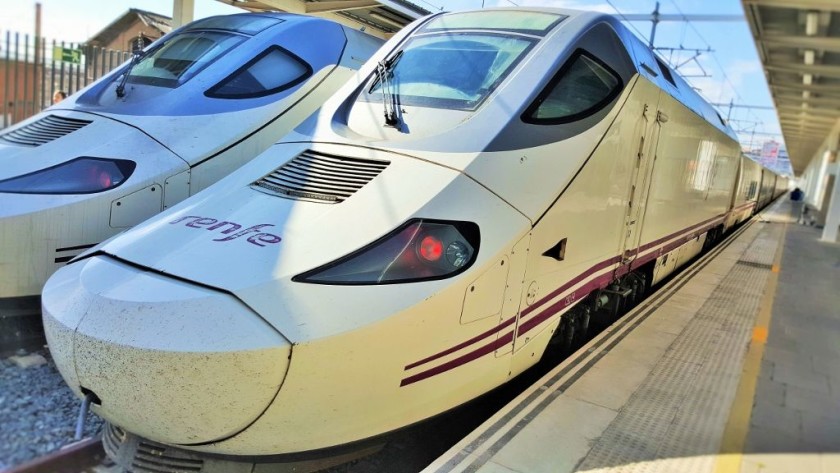
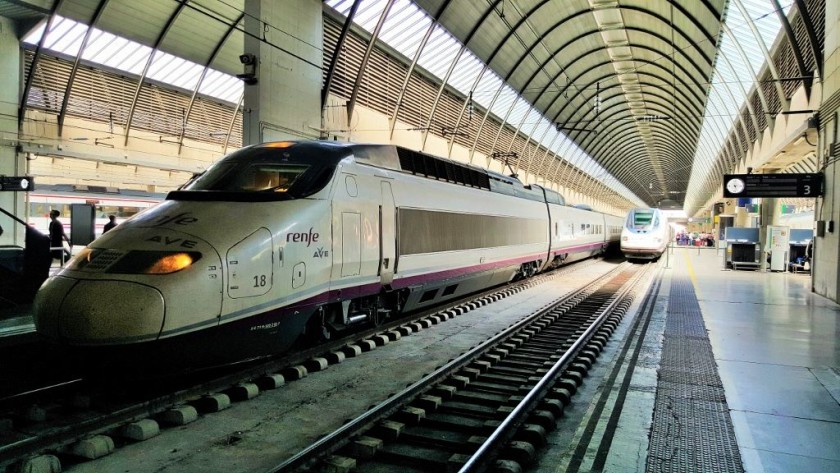


The international rail services:
Spain is served by comparatively few international rail services.
Only FOUR train routes cross its long border with France and just 4 - 7 trains per day use the high speed line that connects the two countries.
Despite this comparatively sparse high speed train service, it apparently justified the removal of all the overnight trains from Spain to France.
On both the Atlantic and Mediterranean coasts the local/regional trains are more frequent, but connections with trains on to other destinations in France need to be planned with care.
What is better news is that the two overnight trains aren't now the only option for heading from Spain to Portugal by train, which is fortunate because it seems those Trenhotel services, which were withdrawn in response to Covid-19, won't ever be resuming.
High Speed RENFE-SNCF services:
The high speed train services between Spain and France on the Mediterranean Coast routes are branded ‘RENFE-SNCF.
They comprise a mix of TGV trains provided by French national rail operator SNCF and Spanish AVE trains provided by Renfe.
The TGV Duplex trains operate on this route in both directions
Paris Gare de Lyon – Valence – Nimes – Montpellier – Narbonne – Perpignan – Figueres/Figueras – Girona/Gerone – Barcelona/Barcelone
Spanish AVE trains operate on these routes in both directions:
(1) Marseille – Nimes – Montpellier – Narbonne – Perpignan – Figueres/Figueras – Girona/Gerone – Barcelona/Barcelone – Camp De Tarragona – Zaragoza – Madrid
(2) Lyon – Valence – Nimes – Montpellier – Narbonne – Perpignan – Figueres/Figueras – Girona/Gerone – Barcelona/Barcelone
(3) Toulouse – Narbonne – Perpignan – Figueres/Figueras – Girona/Gerone – Barcelona/Barcelone (early April – late Sept only)
Some of the departures to/from Toulouse will be by TGV Duplex trains.
Regional trains on the Mediterranean Coast:
There are local cross border services trains from Barcelona to La Tour De Carol
which link with French TER trains between La Tour De Carol and Toulouse; the connections with trains from/to Barcelona were improved for the better a few years ago.
Regional Express trains, which don’t have to be reserved, commence their journeys in Barcelona before calling at Girona, Figueres and Port Bou before terminating over the border in Cerbere.
Most of these trains connect into French TER trains in Cerbere which travel on to Perpignan, Narbonne, Beziers, Montpelllier, Nimes and Avignnon.
In the opposite direction a few French TER trains per day operate on a Avignon – Nimes – Montepellier – Beziers – Narbonne – Perpignan – Cerbere – Port Bou route.
They connect in Port Bou with trains to Figueres, Girona and Barcelona.
In the opposite direction, to France, these French trains now commence their journeys over on the Spanish side of the border in Port Bou, which has significantly expanded the cross border rail travel opportunities, as there are some trains from Barcelona, which don't travel beyond Port Bou.
On the Atlantic Coast:
Over on the Atlantic Coast, the train services aren't branded RENFE-SNCF but TGV Oceane trains operate FROM Paris Montparnasse > Bordeaux > Bayonne > Biarritz > Hendaye TO Irun.
In the opposite direction, to Bordeaux and Paris, these trains commence their journey over the French side of the border in Hendaye.
There are frequent ‘Euskotren’ trains, not operated by RENFE, in both directions on the San Sebastian/Donastia – Irun – Hendaye/Hendaia route.
When travelling to Spain, it's easier to connect into these trains at Hendaye rather than Irun.
In San Sebastian/Donastia connections are available into hourly trains, also operated by Euskotren, which travel on to Bilbao.
Spain to Portugal:
It now seems certain that the Trenhotel overnight services, which provided the only direct train services from Lisbon/Lisboa to Madrid and cities in north-west Spain have been permanently withdrawn.
As a result there are now only two options for taking trains between Spain and Portugal.
(1) Two relatively new 'Celta' train services per day* take this route: Vigo - Valenca - Vana do Castelo - Nine - Porto.
*The trains usually depart from Guixar station in Vigo- daily at 08:58 and 19:56 and the journey from Vigo to Porto takes around 1hr 20mins.
The morning departure from Vigo has good connections in Porto with an IC train on to Lisboa/Lisbon.
The evening departure from Vigo has a 'connection' from a train that has taken an A Coruna - Santiago de Compostela - Pontevedra route.
(2) One train per day, which has tightly timed connections from Madrid, departs from Badajoz and crosses the border to terminate in Entroncamento.
Then in Entroncamento, this train from Badajoz has a 23 minute connection into a train on to Lisboa/Lisbon.
Notes on the major stations in Spain:
Larger stations in Spain don’t have names which equate to ‘Central’ etc, they either have;
- only the main city name
- are named after the part of the city in which they’re located
- are named in honour of an individual.
The larger stations in Spain also tend to have unique characteristics compared to those in other European countries and in summary they are:
(1) Take-away food/drink counters aren’t particularly common, instead canteens/cafés where you sit and have your food/drink are the norm.
So if you want to buy something simple like a bottle of water or a snack, you might have to go into the canteens and purchase it; you won’t have to drink/eat your purchases at the table.
Other shops/news-stands etc in the stations don’t tend to sell drinks and snacks.
(2 Larger Spanish stations don’t tend to house many stores/shops, though Madrid Atocha and Malaga Maria Zambrano station are notable exceptions; so don’t count on being able to stock up on travel essentials at the station.
Finding Your Train & Boarding:

Something to watch out for is that on the main departure screens at stations the ‘departure/salidas’ information is as large as the info for arrivals, so take care not to confuse the two.
The ‘salidas’ info will be on the right and the arrivals will be on the left.
In the station there are also separate, similar looking, info posters listing the details of the arrivals OR the salidas/departures, so take not to mix them up.
The via (platform/track) that a larga-distancia train will be departing from is normally confirmed 15 – 20 mins before departure.
At some stations the departure time on the screens will begin to flash to indicate that boarding has commenced.
Keep an eye on the departure/salidas info screens, as the confirmation of the via (track/platform) that your train will be leaving from, isn’t usually announced.
The system used for assigning numbers to the vias/tracks/platforms at larger Spanish stations can seemingly lack logic, so it’s best not to wonder why and just follow the signs.
The Coche (coach/carriage) and Plaza (seat numbers) will be on your ticket - check the plaza number before you step on to the train.
Boarding an AVE service:
At the main stations the boarding procedure for boarding AVE, Alvia and Euromed train services is similar to checking-in for a flight.
Tickets will be checked before accessing a luggage screening area and then tickets will usually be checked again at the entrance to the via (platform/track) that you’re train will be departing from.
So keep your ticket where you can access it easily, you will need to show it prior to boarding.
Access to the ticket-checks will close around 2 -3 mins before departure, to ensure that all passengers can be processed,
In effect what this will mean is that around 2-3 mins before departure, the train departure details will be removed from the departure info screens.
So would be travellers arriving last minute at the stations, won’t know which via/platform/track, the train will be leaving from.
Because you have to pass through ticket-checks before boarding larga-distancia departures, Spain is a country where you don’t have to be overly concerned about boarding the wrong train in error.
Though to give further reassurance, there are usually electronic displays on the train doors, showing the coach number, the final destinations and the calling points of the departure.
The lounges:
The Club lounges at major stations in Spain can be accessed by;
- Comfort/1st class ticket holders who have booked 'Prémium' tickets.
- Those that have booked 1st or Grand Class beds on the 'Trenhotel' trains
They cannot be accessed by holders of 1st class rail passes.
Left luggage:
The left luggage lockers can only be accessed once you have passed through security checks at the entrances/exits to the left luggage areas of a station, when depositing AND collecting your bags.
As the left luggage offices are staffed, pay attention to the opening hours when dropping off your bags.
Also when you’re picking up your bags don’t go straight to your locker – you will have to hand any other bags you happen to have with you at the time, to the attendant for screening.




Notes on the ticketing:
The Spanish national operator Renfe has recently simplified the types of ticket available and how they can be used which is welcome news.
It can be worth persevering with booking a ticket for a long-distance journey on the Renfe website for these two reasons:
- You can save money by booking in advance;
- Trains can sell out completely days in advance.
Despite the investment in high speed lines, Spanish long distance trains tend to operate less frequently than high speed trains in other European countries
Hence some larga-distancia routes can have only 2 or 3 x trains per day.
It’s worth checking, because when that is the case, it’s not unusual for seats to sell out days in advance in both Preimum (1st) and Estander (2nd) Class on the most popular departures.
Particularly if you will be travelling TO or FROM Barcelona and Madrid on the routes with the infrequent trains.
Saving money:
Limited numbers of discounted tickets are placed on sale online for the routes taken by AVE, Alvia, Euromed, IC trains and the Torre Oro train.
Though pay attention to the terms and conditions of the discounted tickets – more information is available on our Spanish train tickets guide
However, in general, obtaining tickets for the cheapest possible price is less clear cut than is typical in other European countries.
How popular/busy a train is likely to be, tends to have a bigger impact on prices, in comparison to how far in advance you are booking.
There isn't a specific type of ticket that's available at a discounted rate.
On the routes between Madrid and Barcelona and Malaga or Seville a few of the departures can be significantly cheaper, no matter how far ahead you book.
Though with tickets typically available 6 months ahead of the travel date, the very cheapest tickets prices can no longer be available within a few months of the tickets being placed on sale.
On the Alvia routes between Madrid and northern Spain, tickets are placed on sale two months ahead and the further ahead you book, the cheaper the tickets will be.
Tickets aren’t discounted for the shorter distance Avant and Media-Distancia (MD) services and on most RE (Regional Express) services.
Though avoid booking tickets for the Avant services last minute at the station; in particular some Avant trains between Madrid and Toledo can sell out days in advance.
Booking 1st class tickets online:
The online booking service of the Spanish national rail operator, renfe, doesn't sell 1st class tickets, instead the type of tickets available are categorised by the their terms and conditions and the benefits they provide to travellers.
Prémium ticket benefits include a complimentary service of at seat refreshments including a light meal; and as these light meals are only served in Comfort/1st class in AVE and Euromed trains on Mondays to Fridays, if you book a Prémium ticket your seats will be in Comfort/1st class on these trains.
When booking tickets for journeys by the Alvia, AVE, Euromed and Torre Oro trains, along with most journeys by IC trains, Elige tickets will be available and an upgrade to Comfort/1st class will be an option.
Click on the Estander/2nd class price and you will see the 'Elige Comfort' button.
Booking at the station:
If you will be booking tickets/reservations at the station, allow extra time as not all ticket counter staff will speak English, so you may have to wait a little longer for a clerk who can, to become available.
At some large stations including Barcelona Sants and at both Atocha and Charmatin in Madrid, counters selling tickets for travel that day are divided into larga-distancia ticket desks and media-distancia ticket desks.
So take care not to mix up the two, you want to avoid waiting in line for no reason.
Other stations have general ticket offices/desks that sell tickets for any train leaving that day.
Large stations will also have separate ticket desks/offices which only sell advance tickets for larga-distancia journeys.
These advance ticket offices often use AVE branding on the doors and windows, but;
- they will sell advance tickets for other larga-distancia services and not just the AVE trains/services
- they don’t sell tickets for AVE trains departing that day.
Renfe’s ticket machines aren’t, in our humble opinion, particularly easy to use, you have to scroll through the alphabet when searching for stations – and they seemed to only sell tickets for journeys by direct train when we used them.
Also worth knowing:
Unless you will be traveling on the commuter/local train networks in and around the big cities, if you want to book tickets last minute at the station, always check the departure times before heading to a station.
Gaps of more than 4 hours between departures are not uncommon, particularly if you WON’T be travelling to or from Barcelona and Madrid.
Most scenic routes:
Barcelona > Puigcerda > La Tour De Carol
Bilbao <> Santander
Bilbao <> San Sebastian/Donastia
Bilbao <> Miranda de Ebro
Malaga > Ronda > Algeciras
Malaga <> Cordoba
Ferrol <. Gijon
Granada <> Almeria
Leon <> Monforte de Lemos
Leon <> Oviedo
Oviedo <> Santander
Zaragoza <> Canfranc
Zaragoza <> Valencia




Cities
Barcelona
Rail Stations
Bilbao
Rail Stations
Madrid
Malaga
Rail Stations
Sevilla / Seville
Rail Stations
Valencia
Journeys
# Jump to a cityBarcelona
Journeys from Barcelona
Jump to citiesBarcelona to Avignon by train
Barcelona to Béziers / Beziers by train
Barcelona to Bilbao by train
Barcelona to Bordeaux by train
Barcelona to Burgos by train
Barcelona to Figueres by train
Barcelona to Genève / Geneva by train
Barcelona to Girona/Gerona by train
Barcelona to Latour-de-Carol by train
Barcelona to León by train
Barcelona to London by train
Barcelona to Lyon by train
Barcelona to Madrid by train
Barcelona to Malaga by train
Barcelona to Marseille by train
Barcelona to Montpellier by train
Barcelona to Murcia by train
Barcelona to Narbonne by train
Barcelona to Nîmes / Nimes by train
Barcelona to Pamplona by train
Barcelona to Paris by train
Barcelona to Perpignan by train
Barcelona to Port Aventura by train
Barcelona to Port Bou by train
Barcelona to San Sebastian/Donostia by train
Barcelona to Sevilla / Seville by train
Barcelona to Tarragona by train
Barcelona to Toulouse by train
Barcelona to Valence by train
Barcelona to Valencia by train
Barcelona to Zaragoza by train
Journeys to Barcelona
Jump to citiesLyon to Barcelona by train
Madrid to Barcelona by train
Marseille to Barcelona by train
Paris to Barcelona by train
Madrid
Journeys from Madrid
Jump to citiesMadrid to Algeciras by train
Madrid to Avignon by train
Madrid to Avila by train
Madrid to Barcelona by train
Madrid to Bilbao by train
Madrid to Burgos by train
Madrid to Cadiz by train
Madrid to Cordoba by train
Madrid to Girona/Gerona by train
Madrid to Jerez de la Frontera by train
Madrid to León by train
Madrid to Malaga by train
Madrid to Marseille by train
Madrid to Montpellier by train
Madrid to Murcia by train
Madrid to Pamplona by train
Madrid to Paris by train
Madrid to Ronda by train
Madrid to Salamanca by train
Madrid to San Sebastian/Donostia by train
Madrid to Santiago de Compostela by train
Madrid to Segovia by train
Madrid to Sevilla / Seville by train
Madrid to Tarragona by train
Madrid to Toledo by train
Madrid to Valencia by train
Madrid to Zaragoza by train
Journeys to Madrid
Jump to citiesMarseille to Madrid by train
Paris to Madrid by train

This is one of more than 150 train guides available on ShowMeTheJourney, which will make it easier to take the train journeys you want or need to make. As always, all images were captured on trips taken by ShowMeTheJourney.




















